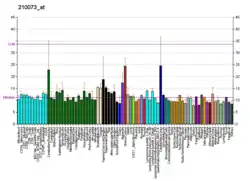ST8SIA1
Alpha-N-acetylneuraminide alpha-2,8-sialyltransferase is an enzyme that in humans is encoded by the ST8SIA1 gene.[5][6]
Gangliosides are membrane-bound glycosphingolipids containing sialic acid. Ganglioside GD3 is known to be important for cell adhesion and growth of cultured malignant cells. The protein encoded by ST8SIA1 is a type II membrane protein that catalyzes the transfer of sialic acid from CMP-sialic acid to GM3 to produce gangliosides GD3 and GT3. The encoded protein may be found in the Golgi apparatus and is a member of glycosyltransferase family 29.[6]
In melanocytic cells, ST8SIA1 gene expression may be regulated by MITF.[7]
References
- GRCh38: Ensembl release 89: ENSG00000111728 - Ensembl, May 2017
- GRCm38: Ensembl release 89: ENSMUSG00000030283 - Ensembl, May 2017
- "Human PubMed Reference:". National Center for Biotechnology Information, U.S. National Library of Medicine.
- "Mouse PubMed Reference:". National Center for Biotechnology Information, U.S. National Library of Medicine.
- Sasaki K, Watanabe E, Kawashima K, Sekine S, Dohi T, Oshima M, Hanai N, Nishi T, Hasegawa M (Dec 1993). "Expression cloning of a novel Gal beta (1-3/1-4) GlcNAc alpha 2,3-sialyltransferase using lectin resistance selection". J Biol Chem. 268 (30): 22782–7. PMID 7901202.
- "Entrez Gene: ST8SIA1 ST8 alpha-N-acetyl-neuraminide alpha-2,8-sialyltransferase 1".
- Hoek KS, Schlegel NC, Eichhoff OM, et al. (2008). "Novel MITF targets identified using a two-step DNA microarray strategy". Pigment Cell Melanoma Res. 21 (6): 665–76. doi:10.1111/j.1755-148X.2008.00505.x. PMID 19067971. S2CID 24698373.
Further reading
- Haraguchi M, Yamashiro S, Yamamoto A, et al. (1994). "Isolation of GD3 synthase gene by expression cloning of GM3 alpha-2,8-sialyltransferase cDNA using anti-GD2 monoclonal antibody". Proc. Natl. Acad. Sci. U.S.A. 91 (22): 10455–9. doi:10.1073/pnas.91.22.10455. PMC 45039. PMID 7937974.
- Nara K, Watanabe Y, Maruyama K, et al. (1994). "Expression cloning of a CMP-NeuAc:NeuAc alpha 2-3Gal beta 1-4Glc beta 1-1'Cer alpha 2,8-sialyltransferase (GD3 synthase) from human melanoma cells". Proc. Natl. Acad. Sci. U.S.A. 91 (17): 7952–6. doi:10.1073/pnas.91.17.7952. PMC 44522. PMID 8058740.
- Sasaki K, Kurata K, Kojima N, et al. (1994). "Expression cloning of a GM3-specific alpha-2,8-sialyltransferase (GD3 synthase)". J. Biol. Chem. 269 (22): 15950–6. PMID 8195250.
- Nakayama J, Fukuda MN, Hirabayashi Y, et al. (1996). "Expression cloning of a human GT3 synthase. GD3 AND GT3 are synthesized by a single enzyme". J. Biol. Chem. 271 (7): 3684–91. doi:10.1074/jbc.271.7.3684. PMID 8631981.
- Matsuda Y, Nara K, Watanabe Y, et al. (1996). "Chromosome mapping of the GD3 synthase gene (SIAT8) in human and mouse". Genomics. 32 (1): 137–9. doi:10.1006/geno.1996.0090. PMID 8786103.
- De Maria R, Lenti L, Malisan F, et al. (1997). "Requirement for GD3 ganglioside in CD95- and ceramide-induced apoptosis". Science. 277 (5332): 1652–5. doi:10.1126/science.277.5332.1652. PMID 9287216.
- Angata K, Suzuki M, McAuliffe J, et al. (2000). "Differential biosynthesis of polysialic acid on neural cell adhesion molecule (NCAM) and oligosaccharide acceptors by three distinct alpha 2,8-sialyltransferases, ST8Sia IV (PST), ST8Sia II (STX), and ST8Sia III". J. Biol. Chem. 275 (24): 18594–601. doi:10.1074/jbc.M910204199. PMID 10766765.
- Zeng G, Gao L, Suetake K, et al. (2002). "Variations in gene expression patterns correlated with phenotype of F-11 tumor cells whose expression of GD3-synthase is suppressed". Cancer Lett. 178 (1): 91–8. doi:10.1016/S0304-3835(01)00817-5. PMID 11849746.
- Strausberg RL, Feingold EA, Grouse LH, et al. (2003). "Generation and initial analysis of more than 15,000 full-length human and mouse cDNA sequences". Proc. Natl. Acad. Sci. U.S.A. 99 (26): 16899–903. doi:10.1073/pnas.242603899. PMC 139241. PMID 12477932.
- Furukawa K, Horie M, Okutomi K, et al. (2003). "Isolation and functional analysis of the melanoma specific promoter region of human GD3 synthase gene". Biochim. Biophys. Acta. 1627 (2–3): 71–8. doi:10.1016/s0167-4781(03)00076-9. PMID 12818424.
- Moon SK, Kim HM, Lee YC, Kim CH (2004). "Disialoganglioside (GD3) synthase gene expression suppresses vascular smooth muscle cell responses via the inhibition of ERK1/2 phosphorylation, cell cycle progression, and matrix metalloproteinase-9 expression". J. Biol. Chem. 279 (32): 33063–70. doi:10.1074/jbc.M313462200. PMID 15175338.
- Ha KT, Lee YC, Kim CH (2004). "Overexpression of GD3 synthase induces apoptosis of vascular endothelial ECV304 cells through downregulation of Bcl-2". FEBS Lett. 568 (1–3): 183–7. doi:10.1016/j.febslet.2004.05.020. PMID 15196944. S2CID 34782656.
- Tomassini B, Malisan F, Franchi L, et al. (2005). "Calnexin suppresses GD3 synthase-induced apoptosis". FASEB J. 18 (13): 1553–5. doi:10.1096/fj.04-1675fje. PMID 15319364. S2CID 44936219.
- Gerhard DS, Wagner L, Feingold EA, et al. (2004). "The status, quality, and expansion of the NIH full-length cDNA project: the Mammalian Gene Collection (MGC)". Genome Res. 14 (10B): 2121–7. doi:10.1101/gr.2596504. PMC 528928. PMID 15489334.
- Teintenier-Lelièvre M, Julien S, Juliant S, et al. (2006). "Molecular cloning and expression of a human hST8Sia VI (alpha2,8-sialyltransferase) responsible for the synthesis of the diSia motif on O-glycosylproteins". Biochem. J. 392 (Pt 3): 665–74. doi:10.1042/BJ20051120. PMC 1316308. PMID 16120058.
- Kang NY, Kang Y, Kang SK, et al. (2006). "Transcriptional regulation of the human GD3 synthase gene expression in Fas-induced Jurkat T cells: a critical role of transcription factor NF-kappaB in regulated expression". Glycobiology. 16 (5): 375–89. doi:10.1093/glycob/cwj087. PMID 16481330.
- Ko K, Furukawa K, Takahashi T, et al. (2006). "Fundamental study of small interfering RNAs for ganglioside GD3 synthase gene as a therapeutic target of lung cancers". Oncogene. 25 (52): 6924–35. doi:10.1038/sj.onc.1209683. PMID 16862187.
- Szabo R, Skropeta D, et al. (2017). "Advancement of Sialyltransferase Inhibitors: Therapeutic Challenges and Opportunities". Med. Res. Rev. 37 (2): 210–270. doi:10.1002/med.21407. PMID 27678392. S2CID 26280291.
This article is issued from Wikipedia. The text is licensed under Creative Commons - Attribution - Sharealike. Additional terms may apply for the media files.




